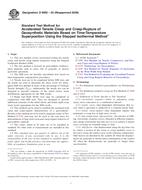Potřebujeme váš souhlas k využití jednotlivých dat, aby se vám mimo jiné mohly ukazovat informace týkající se vašich zájmů. Souhlas udělíte kliknutím na tlačítko „OK“.
ASTM D6992-03(2009)
Standard Test Method for Accelerated Tensile Creep and Creep-Rupture of Geosynthetic Materials Based on Time-Temperature Superposition Using the Stepped Isothermal Method
Automaticky přeložený název:
Standardní zkušební metoda pro urychlený tahu Creep a Creep-prasknutí geosyntetik na superpozice čas-teplota založené Použití osazením izotermické metody
NORMA vydána dne 1.6.2009
Informace o normě:
Označení normy: ASTM D6992-03(2009)
Poznámka: NEPLATNÁ
Datum vydání normy: 1.6.2009
Kód zboží: NS-37238
Počet stran: 8
Přibližná hmotnost: 24 g (0.05 liber)
Země: Americká technická norma
Kategorie: Technické normy ASTM
Anotace textu normy ASTM D6992-03(2009) :
Keywords:
creep, creep-rupture, geosynthetics, ramp and hold test, rapid loading tensile test, stepped isothermal method, time-temperature superposition, Geosynthetics, Isothermal conditions/testing, Stepped isothermal method, Tensile properties/testing--geosynthetics, Time-temperature indicators (TTI), ICS Number Code 59.080.70 (Geotextiles)
Doplňující informace
| Significance and Use | ||||||||
|
Use of the Stepped Isothermal Method decreases the time required for creep to occur and the obtaining of the associated data. The statements set forth in 1.6 are very important in the context of significance and use, as well as scope of the standard. Creep test data are used to calculate the creep modulus of materials as a function of time. These data are then used to predict the long-term creep deformation expected of geosynthetics used in reinforcement applications. Note 1—Currently, SIM testing has focused mainly on woven and knitted geogrids and woven geotextiles made from polyester, aramid, polyaramid, poly-vinyl alcohol (PVA) and polypropylene yarns and narrow strips. Additional correlation studies on other materials are needed. Creep rupture test data are used to develop a regression line relating creep stress to rupture time. These results predict the long term rupture strength expected for geosynthetics in reinforcement applications. Tensile testing is used to establish the ultimate tensile strength (TULT) of a material and to determine elastic stress, strain and variations thereof for SIM tests. Ramp and Hold (R+H) testing is done to establish the range of creep strains experienced in the brief period of very rapid response following the peak of the load ramp. |
||||||||
| 1. Scope | ||||||||
|
1.1 This test method covers accelerated testing for tensile creep, and tensile creep-rupture properties using the Stepped Isothermal Method (SIM). 1.2 The test method is focused on geosynthetic reinforcement materials such as yarns, ribs of geogrids, or narrow geotextile specimens. 1.3 The SIM tests are laterally unconfined tests based on time-temperature superposition procedures. 1.4 Tensile tests are to be completed before SIM tests and the results are used to determine the stress levels for subsequent SIM tests defined in terms of the percentage of Ultimate Tensile Strength (TULT). Additionally, the tensile test can be designed to provide estimates of the initial elastic strain distributions appropriate for the SIM results. 1.5 Ramp and Hold (R+H) tests may be completed in conjunction with SIM tests. They are designed to provide additional estimates of the initial elastic and initial rapid creep strain levels appropriate for the SIM results. 1.6 This method can be used to establish the sustained load creep and creep-rupture characteristics of a geosynthetic. Results of this method are to be used to augment results of Test Method D 5262 and may not be used as the sole basis for determination of long term creep and creep-rupture behavior of geosynthetic material. 1.7 The values stated in SI units are to be regarded as standard. No other units of measurement are included in this standard. 1.8 This standard does not purport to address all of the safety concerns, if any, associated with its use. It is the responsibility of the user of this standard to establish appropriate safety and health practices and determine the applicability of regulatory limitations prior to use. |
||||||||
| 2. Referenced Documents | ||||||||
|
Doporučujeme:
EviZak - všechny zákony včetně jejich evidence na jednom místě
Poskytování aktuálních informací o legislativních předpisech vyhlášených ve Sbírce zákonů od roku 1945.
Aktualizace 2x v měsíci !
Chcete vědět více informací? Podívejte se na tuto stránku.




 Cookies
Cookies
